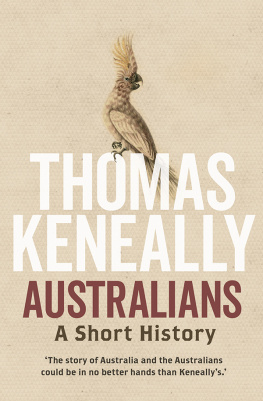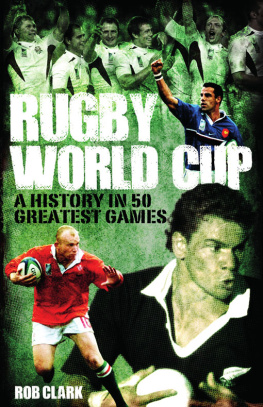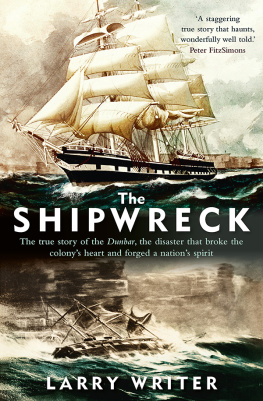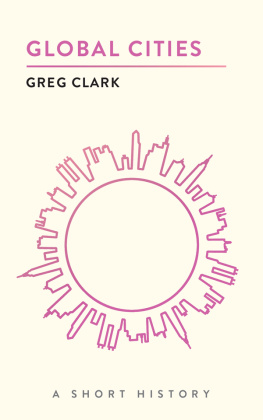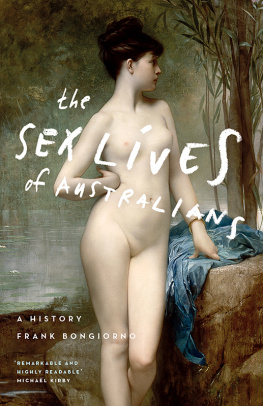Penguin Books
A SHORT HISTORY OF
A USTRALIA
Born in Sydney in 1915, Manning Clark won scholarships to Melbourne Grammar School and the University of Melbourne. He later attended Balliol College, Oxford, and in the early 1940s taught history at schools in England and Australia. He was senior lecturer at the University of Melbourne and, later, Professor of History in the School of General Studies, Australian National University. In 1972 he became the first Professor of Australian History and had honorary doctorates awarded by the Universities of Melbourne, Newcastle and Sydney.
In 1975 Manning Clark was made a Companion of the Order of Australia, in recognition of his six-volume A History of Australia, and was named Australian of the Year for 1980. Professor Clark died in 1991.

BY THE SAME AUTHOR
Select Documents in Australian History 17881850
Select Documents in Australian History 18511900
A History of Australia, volumes IVl
In Search of Henry Lawson
Occasional Writings and Speeches
Collected Short Stories
The Puzzles of Childhood
The Quest for Grace
A SHORT HISTORY OF
A USTRALIA
MANNING CLARK
Fourth Revised Edition
Penguin Books
PENGUIN BOOKS
Published by the Penguin Group
Penguin Group (Australia)
250 Camberwell Road, Camberwell, Victoria 3124, Australia
(a division of Pearson Australia Group Pty Ltd)
Penguin Group (USA) Inc.
375 Hudson Street, New York, New York 10014, USA
Penguin Group (Canada)
90 Eglinton Avenue East, Suite 700, Toronto, ONM4P 2Y3, Canada
(a division of Pearson Penguin Canada Inc.)
Penguin Books Ltd
80 Strand, London WC2R 0RL, England
Penguin Ireland
25 St Stephens Green, Dublin 2, Ireland
(a division of Penguin Books Ltd)
Penguin Books India Pvt Ltd
11, Community Centre, Panchsheel Park, New Delhi-110 017, India
Penguin Group (NZ)
67 Apollo Drive, Mairangi Bay, Auckland 1310, New Zealand
(a division of Pearson New Zealand Ltd)
Penguin Books (South Africa) (Pty) Ltd
24 Sturdee Avenue, Rosebank, Johannesburg 2196, South Africa
Penguin Books Ltd, Registered Offices: 80 Strand, London WC2R 0RL, England
First published 1963
This edition published by Penguin Group (Australia), 2006
Copyright Sebastian Clark 1963, 1969, 1980, 1981, 1983, 1986, 1992, 1995, 2006
All rights reserved. Without limiting the rights under copyright reserved above, no part of this publication may be reproduced, stored in or introduced into a retrieval system, or transmitted, in any form or by any means (electronic, mechanical, photocopying, recording or otherwise), without the prior written permission of both the copyright owner and the above publisher of this book.
www.penguin.com.au
ISBN: 978-1-74-228325-8
For Sebastian and Elizabeth
and in memory of Katy Clark
CONTENTS
ONE
The Coming of the Aborigine and the White Man
So far there have been two cultures in Australia one Aboriginal and the other European. Like the Americans, Australia was probably first colonized by Homo sapiens, as distinct from his antecedents, during the last ice age. Carbon tests have established the presence of such a man on the mainland of Australia at least fifty thousand years ago. The same tests have shown that a physically modern man probably was not active in Tasmania until much later.
The reason for this is simple. At the time when the Aborigines first colonized Australia, there was probably an ice barrier which effectively barred human occupation across the southeastern part of the continent where the Snowy Mountains now stand. During the passage of time between the coming of the Aborigine more than fifty thousand years ago and the coming of the white man in 1788, the changes in the appearance of Australia were caused probably more by changes in climate than by human activity. For apart from fire, the stone implements he used for hunting and food gathering, and the rock paintings on which he portrayed his vision of the world, the Aborigine handed on to posterity few other memorials of his encounter with the weird and harsh land his people had occupied since time immemorial.
Some time in the last ice age there was a revolution in climate during which the ice receded from the southern part of the continent, thus making possible mans colonization of the islands in Bass Strait and Tasmania. Those who survived the revolution in climate developed a culture but not a civilization of their own. Their numbers remained few: on the mainland there were at least three hundred thousand, and in Tasmania between four and seven thousand. While the inhabitants of most of Asia and of the islands from Sumatra to the Moluccas and Timor gradually progressed from a hunter-gatherer society to civilization, the Aborigines retained their primitive Stone Age culture.
The absence of suitable seed-bearing plants and animals suitable for domestication probably were the main causes of this changelessness, though their cosmology also contributed to it. So they lacked the material strength to resist an invader.
Not that they were called upon to defend themselves. As other peoples made the transition from a primitive culture to civilization, chance protected the Aborigines from such an invader. By the second millennium BC, people who had made the step forward to civilization began to migrate towards the continent. The Malays began their first invasion of the Indonesian Archipelago probably two thousand years before the birth of Christ, but they did not reach Australia. In the first century of the Christian era the Hindu-Buddhist people from southern India began to colonize the islands of Indonesia in search of gold, spices, and converts to their religion. Their expansion farther east or south of Lombok was arrested, not by the absence of any incentive, but by the crisis in the mother country caused by the Muslims, who invaded northern India in the fifteenth century and destroyed the Hindu states in Indonesia during the fifteenth and sixteenth centuries. Similar causes interrupted Chinese settlement of the islands, which began in the ninth century. By the early fifteenth century Chinese were trading with Sumatra, Java, Timor, and Macassar in the Celebes. The Chinese interest in the trepang and the bird of paradise, which commanded high prices in Peking, had caused them to use the Bugis seamen from Macassar as carriers. The exhaustion of the trepang fishing-beds close to Macassar sent the Bugis in time as far afield as the northern coast of Australia, to which they gave the name Marege, or land of the trepang.
In 1432 a palace revolution in Peking brought to power a group opposed to foreign trade and discovery. This ended Chinese expansion in the South Seas till the nineteenth century. For a time Muslim merchants from the western coast of India and from the Persian port of Ormuz inherited the trade and with it the role of civilizer formerly exercised by the Hindu and the Chinese till their expansion to the east and the unknown south was halted by the arrival of the European at the beginning of the sixteenth century.
In this way the expansion of all three Hindu, Chinese, and Muslim petered out just as they came to that invisible line on the map between Timor and the Moluccas where civilization ended and primitive societies began. So chance probably prevented the coming of civilization to Australia two or three centuries before the arrival of the European. The history of Asian colonization in the area, however, influenced the European. The Hindus invented the story of islands of gold to the south and east of Java; it was while searching for these islands of gold that the European bumped into the north coast of Australia. The material weakness of the Hindu, Chinese, and Muslim kingdoms in Indonesia made possible the coming of the European. All three invented stories to deter their seamen from sailing into the unknown seas to the south and south-east of Java because their ships, their navigation instruments and their ideas on the shape of the world confined their sailors to the role of coast-huggers. Improvements in shipbuilding, aids to navigation and cartography at the end of the fifteenth and the beginning of the sixteenth centuries enabled the European to scoff at such stories as the products of superstition, ignorance, and material weakness. While the Hindu had been deterred by the fear of being sucked into the maelstrom of Pausengi, the Chinese by stories of the kingdom of women and great holes in the ocean, and the Muslims by reports of the kingdom of anti-Christ, the European was driven on by an overwhelming confidence in his powers as well as the same greed for material gain and the same religious zeal that had motivated the Hindu, the Chinese and the Muslim.
Next page

